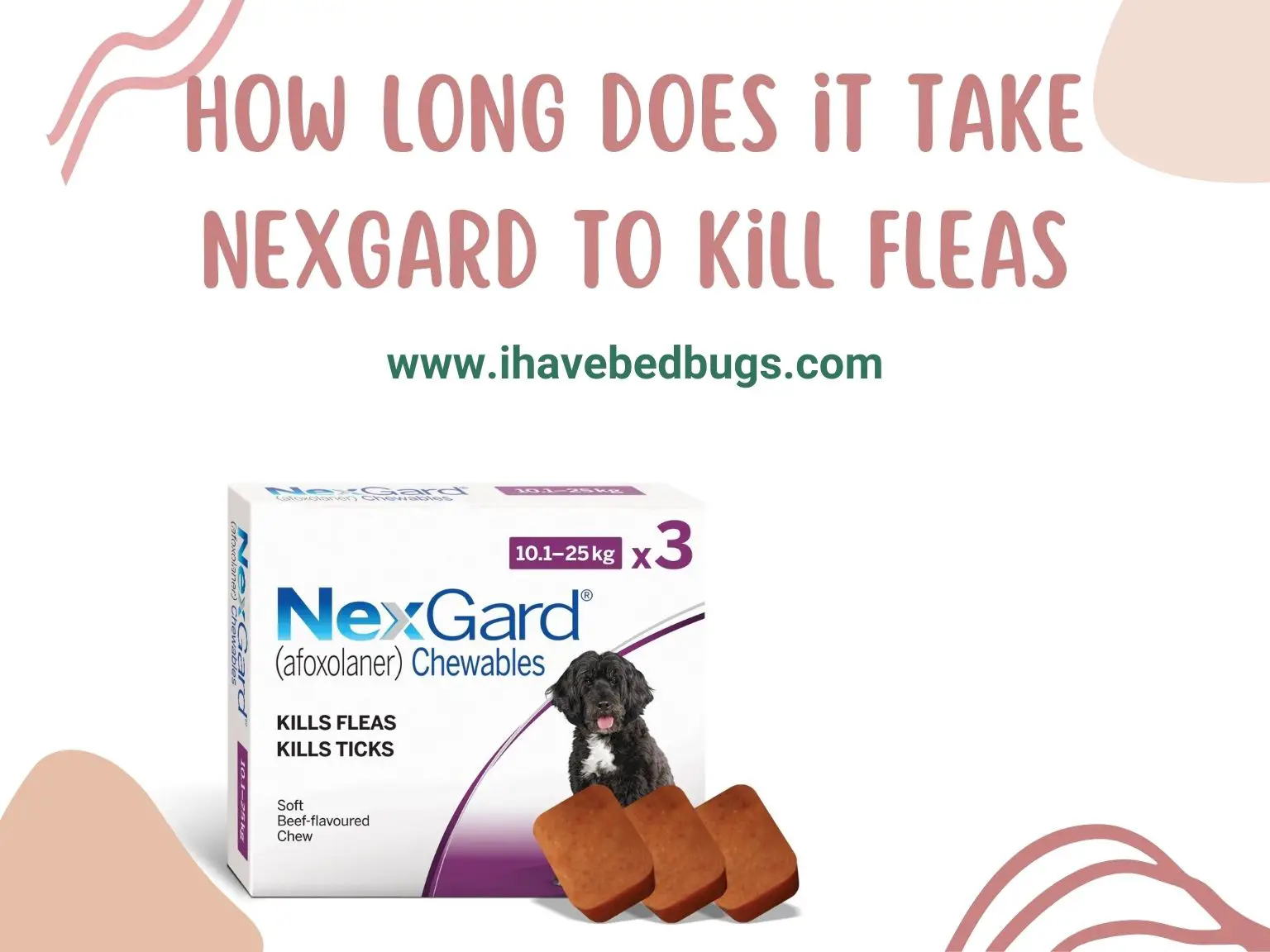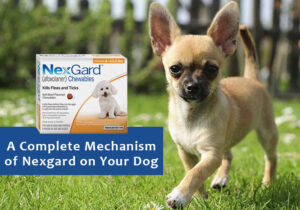If you ask pet owners what’s the most annoying thing about having pets, they’ll tell you it’s the endless fleas and ticks. So, of course, many products are available nowadays for tick and flea control. These products can either kill the pests or disrupt their life cycle in some way or another. Unfortunately, however, not all products are effective, and some take a long time before you start seeing any results.
Accordingly, in this article, we’ll be talking about NexGard and how it works to eliminate your pet’s flea infestation.
We’ll also tell you some of its advantages as well as frequently reported adverse reactions to the drug. But, most importantly, we’ll let you know how fast NexGard kills adult fleas and what you should do to prevent the reappearance of more fleas on your canine friend.
So, keep on reading to discover everything you need about NexGard as a pet owner.
What Is NexGard?
NexGard is a medication used for flea and tick protection in dogs. It was launched in 2013 as the first oral flea-and-tick-control product and came in the form of a chewable.
NexGard contains afoxolaner as its active ingredient, which is able to kill fleas and four types of ticks (American dog ticks, lone star ticks, black-legged ticks, and brown dog ticks) within a short period of time.
Amazingly, NexGard has also been approved by the EU for the treatment of demodectic and sarcoptic mange infestations in dogs, though it has yet to be authorized for use in the USA.
Nonetheless, it remains a highly effective solution to control most flea and tick infestations, nut only for dogs and dogs alone. So, make sure to find your other pets another form of flea and tick treatment, or you risk endangering them.
Does NexGard Kill Fleas or Make Them Jump Off?
Luckily, NexGard totally kills off adult fleas thanks to its active ingredient, afoxolaner. This compound works by overstimulating the fleas’ nervous system until they die.
Once your dog eats the NexGard treat, afoxolaner gets absorbed through its intestine to reach its bloodstream. After that, the flea-killing compound remains stored underneath your dog’s coat, ready to act once the blood-suckers bite.
When they do, afoxolaner binds to the fleas’ nerve cells and prevents them from communicating with each other properly by blocking the movement of chloride ions. Consequently, the pests’ nervous system will become uncontrollably over-excited, ultimately leading to their paralysis and death.
As the fleas die, they rise till they appear on the top of your dog’s haircoat. So when you see the dead fleas, just give your canine friend a good brush, and you’ll have yourself a clean, flea-free boy.
Do Fleas Have To Bite For NexGard To Work?
Yup. As we previously mentioned, NexGard is given orally, so it’s present on the inside of your dog’s body, not outside as most other flea medications.
So, in order for the flea to be affected by the active ingredient, it has to bite your dog and get its blood meal. This is the only way it can ingest the thing that will kill it. The same thing applies to ticks.
So, as unfortunate it is, your dog has to suffer a few bites before it can finally be rid of the flea infestation. However, it’s not a bad trade-off for living a whole month without any fleas.
Does NexGard Kill Flea Eggs?
No, NexGard simply can’t kill or affect the growth of flea eggs. Only adult fleas are affected since they have to ingest the active ingredient.
Still, you don’t have to worry about this at all.
That’s because NexGard kills adult fleas long before they have a chance to lay eggs. And as for the eggs already present on your dog, once they hatch and grow into full-fledged fleas, they’ll also bite the bullet within NexGard’s period of action.
Can My Dog Still Have Fleas After Using NexGard?
If you’ve used NexGard chewables correctly, as in the proper dose at the proper time, then no, your dog won’t have fleas after using NexGard.
This means that the NexGard chewables need to be properly stored and within the expiration date to be fully effective. Additionally, you must ensure your dog properly swallows the entire chewable and doesn’t throw it up. If it happens to vomit in less than two hours from when you’d given it the medication, then you need to re-administer NexGard in its full dosage.
One thing you’d do well to remember is that you need to administer NexGard monthly if you live in a highly infested environment, be it your home or neighborhood. If you don’t, the fleas and ticks will reappear, causing you and your dog an endless amount of grief.
As you know, NexGard can only kill the fleas that are living and feeding on your dog, and it performs its job wonderfully for about 30 days. However, NexGard leaves your pet’s system after that period, leaving it liable to further infestation from flea-ridden areas like parks. So, to avoid the reappearance of those pesky pests, you should always maintain a monthly dosing schedule for your doggo.
Another situation where you may see fleas reappearing on your dog is if you’re the owner of multiple pets. Here, the other dogs or cats will act as a major flea source.
So, while the dog using NexGard will be flea-free for a month, it will immediately be ambushed by the annoying pests once the month is over. Accordingly, you need to dose all your pets with NexGard or other flea-control medications to prevent this occurrence.
How Long Does It Take NexGard to Kill Fleas and Ticks?
Impressively, NexGard starts killing fleas in about 4 hours.
After you’ve given your dog its dose for the month, afoxolaner starts to work after 30 minutes, leading to the first flea deaths in as little as 4 hours.
After four more hours, the medication will have killed more than 99% of the flea infestation your doggo is suffering from, and within 24 hours, there won’t be any fleas left alive.
Nevertheless, if your house or building has severe flea infestations, you’ll be noticing fleas on your dogs even after the 24 hour period. That’s because numerous fleas will be jumping from various nooks and crannies, trying to find their next meal. And when they settle on your dog, they’ll be meeting their demise once they take their first bite.
As for ticks, NexGard takes a little longer to work.
Almost every black-legged tick, aka deer tick, dies within 48 hours of ingestion. Meanwhile, the Lone Star tick, Brown dog tick, and American dog tick are killed within 72 hours.
Now, as we said, afoxolaner kills fleas almost completely in the first 24 hours, and it remains active and effective for about five weeks. Accordingly, it can break the life cycle of any flea form present on your dog’s coat, be it egg, larva, or adult flea.
As for its efficacy on ticks, a 2014 study demonstrated that it had a 98.4% efficacy against deer ticks in the first 48 hours. After this period, the efficacy slightly falls to 94%, but it remains strong for a whole month.
Similarly, NexGard was 98.8-100% effective against Brown dog ticks in the first 48 hours, and it remains 95% effective for a period spanning five weeks.
So, in a nutshell, NexGard kills adult fleas within 8-24 hours and ticks within 48-72 hours, ad it remains active for 4-6 weeks within your dog’s body. However, it can persist for even longer in dogs with liver disease or kidney failure.
NexGard Benefits and Advantages
First off, NexGard chewable tablets are, well, chewable. This means that you don’t have to worry about separating your dogs from other pets or family members as you would with other external flea and tick treatments that go on the skin.
You also don’t have to keep an eye on your dog in case it starts licking its coat or worry about when to give it a bath, as the active material is contained under your dog’s haircoat. In fact, you can take your dog swimming and get it wet immediately after taking NexGard, and the treatment will still work perfectly.
Another thing that we greatly appreciate about this flea and tick treatment is that it’s beef-flavored. This makes administering NexGard pain-and-hassle-free for both you and your dog.
Now, of course, if your dog is on the picky side, it may not readily accept the treat. However, you can still easily hide it within its favorite food, and it’ll gobble the tablet up with no problem.
We also love the fact that NexGard comes in four different dosages. This makes it suitable for all dog breeds and sizes, as long they’re at least eight weeks old and weigh a minimum of 4 pounds (1.8 kilograms).
Needless to say, we also love its rapid action and effectiveness against both fleas and ticks. It’s also worth noting that NexGard is the only licensed flea-and-tick-control product that can prevent Lyme disease in dogs through its action on black-legged ticks. So, if your area is known to have those nasty pests, make sure to protect your pooch by regularly administering NexGard.
As we previously mentioned, NexGard can be effectively used to treat Scabies and demodicosis, which are two types of mange caused by mites. They’re especially common with young pups, whose young age can make treatment tricky.
However, since NexGard can be administered to puppies as young as eight weeks, it makes it an excellent product for treating these two types of mange as early as possible.
The final thing about NexGard that truly makes it great is that it can be safely taken with most other medications. Astonishingly, you can use NexGard concomitantly with vaccines, antibiotics, anthelmintics, corticosteroids, antihistamines, nonsteroidal anti-inflammatory drugs (NSAIDs), and anesthetics.
NexGard Disadvantages
As with everything, there’s a good side and a bad side. So, as marvelous as we’ve made NexGard sound, you need to consider a few things before getting it for your pet.
Unfortunately, NexGard has a number of side effects. Thankfully, though, they’re all quite rare, and when they do occur, they usually go away on their own relatively quickly. Nevertheless, if your pup happens to experience any of those adverse reactions, we highly recommend you talk to a licensed veterinarian immediately just to be on the safe side.
Now, the most frequently reported adverse reactions include vomiting, nausea, loss of appetite, and diarrhea. Generally, vomiting is the most encountered side effect. It tends to occur more during a dog’s first time taking NexGard.
Skin conditions such as dermatitis can also occur with NexGard. They usually manifest as itching, red skin that noticeably causes your dog to scratch. Occasionally, your dog may have an allergic reaction to the medication, which results in the appearance of hives or localized areas of swelling, especially near the muzzle and face.
The final adverse reaction you can see with NexGard is some sort of neurological issue like seizures, tremors, and ataxia. This happens because afoxolaner belongs to a class of parasiticides called isoxazoline, which have been known to occasionally cause neurologic reactions.
Thankfully these effects are extremely rare, but they can appear in both healthy dogs and dogs with a history of neurologic disorders such as epilepsy. However, since they occur more frequently with the later kind, NexGard should never be used with these types of dogs.
A major disadvantage of NexGard is that it doesn’t work on chewing lice, unlike some other pest treatments. It can kill ticks and control flea infestations like magic, but it’s useless against lice.
You should also know that NexGard’s safety has yet to be evaluated in pregnant, breeding, or lactating dogs. So, you’d do well to keep it away from your dog if any of the previous conditions apply to it, at least until we know more about its effects.
FAQs
Is NexGard Safe for Cats?
No. NexGard is only made for use on Dogs. You shouldn’t give to cats or any other pet.
Where Can I Buy NexGard for Dogs?
NexGard is available for sale both online and in-store. However, it requires a prescription to be sold. If the seller tells you a prescription isn’t necessary, then there’s a very high chance that the product is a counterfeit.
What Happens if I Don’t Give My Dog NexGard at the Specified Dosing Schedule?
If you’ve missed a dose, then simply give your pup one as soon as you remember. Just remember the date so that you can give your dog the next dose at the right time.
What Should I Use If My Dog Has Lice?
If you suspect your dog has fleas or lice, then it’s best you use Frontline or Seresto collars. Unlike NexGard, they’re great at controlling lice, and they also prevent the appearance of more fleas on your beloved pet.
Conclusion
NexGard is mighty great at killing adult fleas and ticks. Once taken orally, NexGard stimulates the fleas’ nervous system to such a degree that it causes their death. Thankfully, it does so quite quickly, where it kills most fleas within 8 hours, leaving your pet without fleas in exactly 24 hours.
Naturally, as with any other flea and tick protection, NexGard has some side effects that include vomiting, itching, lethargy, loss of appetite, and diarrhea. However, when compared to its benefits, NexGard is still highly recommended for flea and tick control by almost every licensed veterinarian.
So, if you want to get NexGard for dogs, make sure to get a prescription from your vet, as you won’t be able to buy it over the counter.
References
- https://www.ema.europa.eu/en/documents/overview/nexgard-epar-medicine-overview_en.pdf
- https://www.fda.gov/animal-veterinary/cvm-updates/fda-approves-nexgard-prevention-infections-cause-lyme-disease-dogs
- https://vcahospitals.com/know-your-pet/afoxolaner
- https://www.gilbertsvillevet.com/nexgard/
- http://www.nexgardfordog.com/about-nexgard-flea-and-tick-protection.html
- https://nexgardfordogs.com/flea-Infestation
- https://fluentwoof.com/nexgard-for-dogs-review/
- https://www.veterinarians.org/nexgard/





